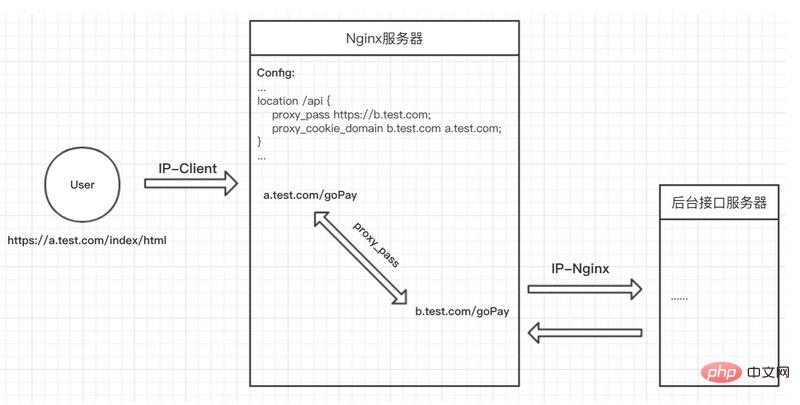Home >Operation and Maintenance >Nginx >Nginx reverse proxy cross-domain basic configuration method
Nginx reverse proxy cross-domain basic configuration method
- WBOYWBOYWBOYWBOYWBOYWBOYWBOYWBOYWBOYWBOYWBOYWBOYWBforward
- 2023-05-13 21:49:101454browse
nginx interface service reverse proxy basic configuration
server {
listen 8443; # 监听的端口号
server_name a.test.com; # 服务器名称
client_max_body_size 100m; # 定义读取客户端请求头的超时时间
ssl on;
ssl_certificate test.pem;
ssl_certificate_key test.key;
ssl_session_timeout 5m;
ssl_protocols sslv3 tlsv1.2;
ssl_ciphers ecdhe-rsa-aes256-sha384:aes256-sha256:rc4:high:!md5:!anull:!enull:!null:!dh:!edh:!aesgcm;
ssl_prefer_server_ciphers on;
location / {
root /test-static-app; # 静态资源目录
index index.html index.htm;
try_files $uri $uri/ /index.html; # 动态解析目录,配合vue的history模式
}
}The basic configuration implements the basic functions of the page and static server, and can implement routing when using vue’s history mode parse. Furthermore, in order to achieve unified forwarding to the interface server, we need to specify the prefix of the interface name with the back-end developer. For example, the relative paths of all interfaces start with api. At this time, we can add the following configuration (equal to the previous location ),
...
location /api {
proxy_pass https://b.test.com; # 设置代理服务器的协议和地址
proxy_cookie_domain b.test.com a.test.com; # 修改cookie,针对request和response互相写入cookie
}
...which mainly relies on proxy_pass to forward the /api/x interface under a.test.com to b.test.com. The process is roughly as follows

The cookie interaction is mainly proxy_cookie_domain, plus the following paragraph
proxy_cookie_domain b.test.com a.test.com;
This realizes the transfer and write-back of cookies between the a.test.com and b.test.com domain names.
If you use node to simulate it, it is roughly as follows
module.exports = (router) => {
router.get('/api/index/getcmsinfo', async function (ctx, next) {
// 接口转发
let result = await superagent.post('https://b.test.com/api/card/home').set(browsermsg)
// 获取返回的set-cookie,并设置header
let setcookie = result.headers['set-cookie']
if (setcookie) {
ctx.response.header['set-cookie'] = setcookie
}
// 返回
ctx.response.body={
success: true,
result: result.body
}
})
}To sum up, the essence of nginx reverse proxy is actually the forwarding of interface services and header processing. It is easy to understand if you think about it carefully. .
Common misunderstandings
1. Useless aca-header?
Many nginx cross-domain settings on the Internet have added content related to cross-domain header settings, such as
add_header 'access-control-allow-origin' '*'; add_header 'access-control-allow-credentials' "true"; add_header access-control-allow-headers x-requested-with;
Think about the above principles, do you think this is still useful? ? The header of the aca (access-control-allow-) series is configured for cross-domain negotiation in CORS. It is simply unnecessary to take off your pants and fart here.
2. Does the proxy_pass domain name contain ‘slash/’?
Similarly, I saw on the Internet that some netizens will add a slash after configuring proxy_pass, as shown below, and then say that an error is reported and the interface cannot be found~How to fix it~
...
location /api {
#proxy_pass https://b.test.com;
proxy_pass https://b.test.com/;
}
... Let’s think about it after seeing this. The function of proxy_pass is to catch the request. Adding a slash means that all /api requests will be forwarded to the root directory, which means /api will be / Instead, the interface path has changed at this time, and one layer/api is missing. What about without adding a slash? This means that when forwarded to the domain name of b.test.com, the /api path will not be lost.
In this case, if the backend interface has a prescribed prefix, such as /api, then you do not need to configure the slash here. In another case, the back-end interface shit is the same, without a unified prefix. Here we need to distinguish, then add a unified prefix to all front-end interfaces, such as /api, and then replace it by adding a slash~
The above is the detailed content of Nginx reverse proxy cross-domain basic configuration method. For more information, please follow other related articles on the PHP Chinese website!

